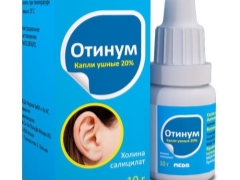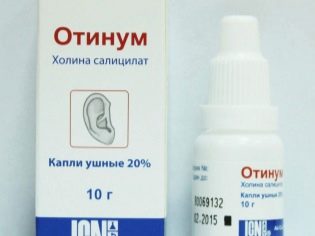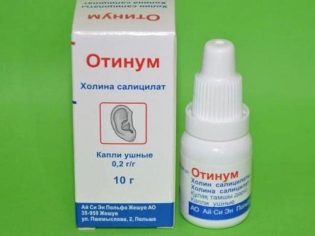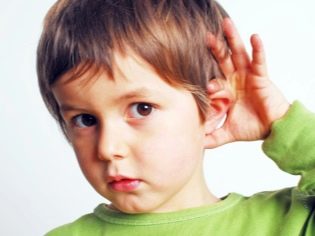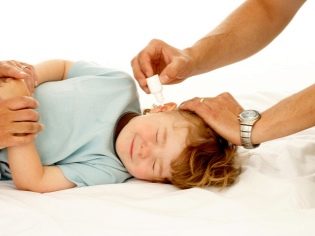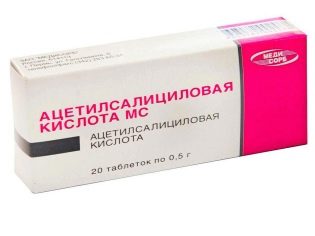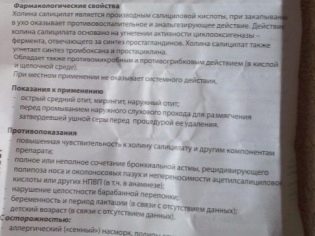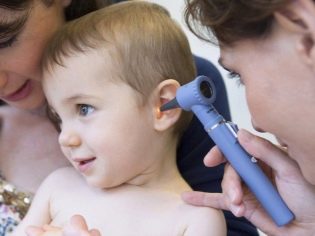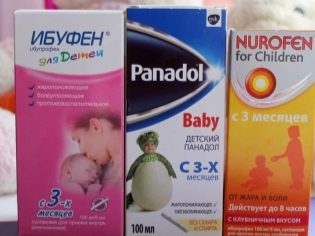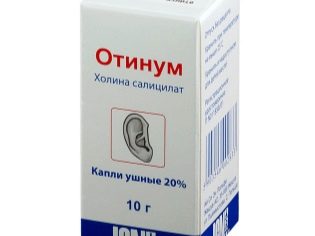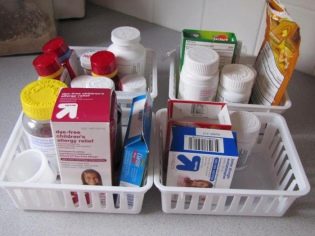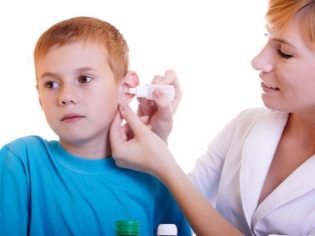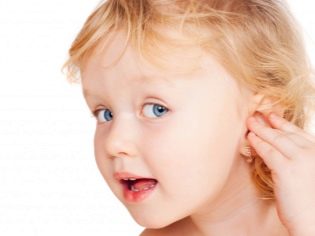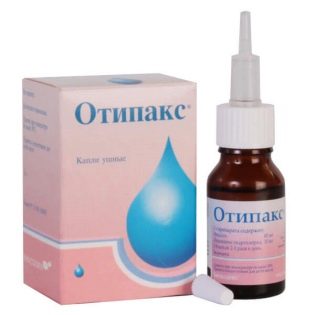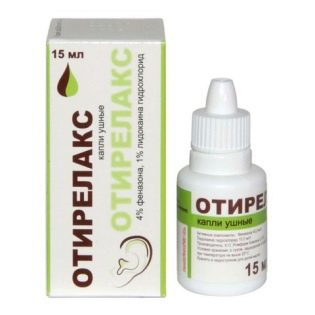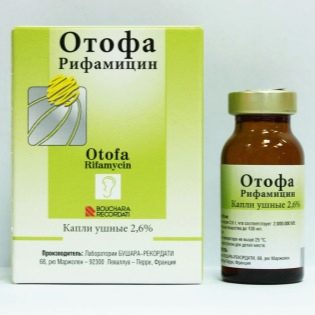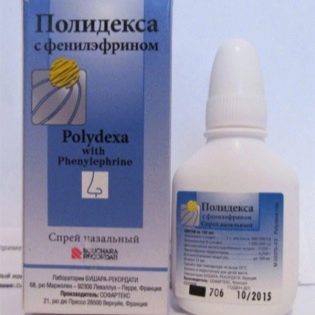Otinum for children: instructions for use
If an adult’s ear has inflamed, it is immediately recommended that some kind of ear drops help to eliminate the inflammatory process and soothe the pain, which is often very severe in otitis. One such tool is Otinum.
Is it possible to drip such a drug to children, in what dosage it is used for young patients and how it acts on the ear tissue and the body as a whole?
Release form
Otinum is produced only in one form, representing ear drops. They are sold in white plastic bottles that have a dropper tightly closed with a lid.
One bottle contains a clear solution with a specific odor and a light yellow color in the amount of 10 grams.
Composition
The main ingredient by which drops help with ear inflammation is choline salicylate. Since the solution is 20%, this compound in 1 ml of Otinum is represented by a dosage of 200 mg.
As excipients in the preparation, as in many other ear drops, there is ethyl alcohol and glycerol. In addition, the solution contains purified water and chlorbutanol hemihydrate.
Operating principle
Choline salicylate as part of Otinum is a non-steroid substance with anti-inflammatory action (refers to salicylic acid derivatives). Therefore, when it falls into the ear drops reduce pain and help get rid of the inflammatory process.
Such effects are associated with the ability of choline salicylate to inhibit cyclooxygenase - an enzyme that controls the synthesis of prostaglandins.
The medication also has some antifungal and antimicrobial effects, and, thanks to the glycerol in its composition, Otinum, which has fallen on hardened earwax, softens it and makes it easier to remove from the ears.
In this case, the drops act exclusively locally and, if the drum wall is intact, their components do not enter the bloodstream and do not affect the internal organs in any way.
Indications
Otinum apply:
- In children with otitis externa.
- In patients with otitis media in acute form.
- In babies with inflammation of the eardrum.
- In small patients with sulfuric cork (medicine is injected to soften sulfur before rinsing the ear canal).
From what age is appointed?
The drop note contains information about the limited use of Otinum in childhood, which is associated with insufficient research on the safety of medicines for children. However, ENT doctors and pediatricians prescribe this drug from 1 year, because it acts only locally.
Wherein use of Otinum without inspection of the child is inadmissibleAfter all, one of the main contraindications to its use is damage to the eardrum.
The drug can be administered to children up to a year, but only under the supervision of a doctor.
Contraindications
Otinum is not appointed:
- in case of hypersensitivity to choline salicylate and other ingredients of the drops;
- allergic to acetylsalicylic acid;
- with perforation of the eardrum.
If a child has an allergic rhinitis, polyps in the nose, or there was once an allergic reaction to any nonsteroidal anti-inflammatory drugs, Otinum can only be used under the supervision of a specialist.
Side effects
The drug can cause itching, rashes and other allergic reactions.Some children complain of a burning sensation after the solution gets into the ear.
If you drip the medication during perforation of the eardrum, it leads to hearing impairment.
Instructions for use
The drug is used, observing the following rules:
- If the medication is prescribed in the inflammatory process, it is used three times (in some cases four times), instilled into the ear canal in 3 or 4 drops.
- The duration of treatment, according to the abstract, should not be more than 10 days. If the symptoms persist, the child needs additional medical advice and the selection of another medication.
- To show the baby to the doctor should also be the case if on the second or third day of treatment with Otinum no positive dynamics are observed.
- If Otinum is used with a sulfuric plug, the drug is administered 3 or 4 drops at a time into the ear twice a day for 4 days in a row.
- If the medicine is stored in the refrigerator, it must be warmed in the hands before use, otherwise the cold solution will cause discomfort in the child.
- To drip the drug, the child must lie on its side, and his head - remain in a horizontal position for some time after the procedure.
- In the youngest patients, you can use wadded turundas by dropping Otinum cotton wool and placing the flagellum in the ear canal of the baby.
Overdose
The manufacturer does not give any data on the negative effects of high doses of Otinum.
Interaction with other drugs
If Otinum is used together with any antipyretic, anti-inflammatory or analgesic drugs, their effect will be enhanced.
Terms of sale
Otinum is an over-the-counter medicine and is freely sold in pharmacies, but when used in children, buying it without consulting a doctor is not recommended.
The average price of one pack of medicine is 200 rubles.
Storage conditions
The shelf life of the sealed bottle Otinum is 3 years. It does not change after opening the bottle.
Keep the drug at home is allowed at room temperature, but many parents put the drops in the refrigerator, which is not prohibited by the manufacturer.
Reviews
The treatment of children Otinum speak mostly positively. The drug is praised for its rapid therapeutic effect and it is noted that it removes painful sensations well, as a result, it alleviates the condition of the child with otitis.
In addition, the advantages of drugs called long shelf life, easy to use bottle and low cost.
According to moms, the burying of Otinum usually does not cause any discomfort, but The remedy is tolerated by most children well.
Analogs
If a child with otitis media for some reason cannot use otinum, the doctor may advise other ear drops, for example:
- Otipaks. The composition of this medication includes lidocaine and phenazone, and since both of these substances have an analgesic effect, Otipaks quickly and relieves pain in the ear for a long time. It is allowed to use it in childhood from birth.
- Otyrelax. This tool is similar to Otipaksu, that is, it contains the same active ingredients and helps to eliminate painful otitis. This medication is also prescribed at any age.
- Anauran. This medication includes antibacterial substances, to which anesthetic is added. It is used in the treatment of children older than 1 year.
- Polydex. In such drops, two antibacterial compounds are combined with a glucocorticosteroid, therefore Polydex effectively copes with otites of different nature. In pediatrics, such a drug is allowed from birth.
- Otofu. Such a locally effective antimicrobial agent can be used even if the eardrum is damaged, therefore, if a tear is found, it can be chosen as an analogue to Otinum and other drops prohibited during perforation. The doctor may prescribe it to patients of different ages, if there are indications for this.
- Sofradex.The composition of such drops includes two antibacterial components and the hormone glucocorticoid. This medicine is often used for otitis in children, prescribing to patients older than a month.
Any of these medications can be given to children, but without consulting a doctor, any ear drops may not improve the condition of the little patient, but on the contrary, harm the baby.
For this reason, when complaining of ear pain, fever and other otitis symptoms, you must first show the child to the pediatrician and undergo an examination at the ENT, and only after that apply the drops that the specialist will recommend in the treatment.
Self-treatment of ear diseases in children can lead to complications, such as hearing impairment.
How to treat otitis media in children, see the following video.
